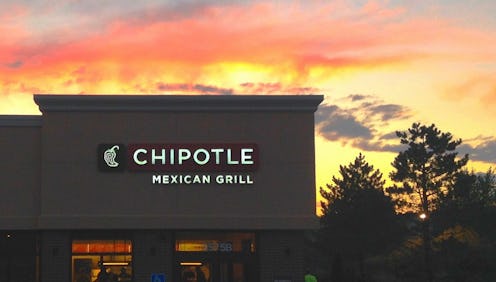
Today brings more unfortunate news for those can't go a week without the culinary wonder that is the Barbacoa Burrito Bowl (with Tomatillo Red Salsa, naturally). According to the Centers for Disease Control, the Chipotle-linked E. coli outbreak that began in early November has spread. So if you're anything like me, a deep internal struggle is being waged between the inner voice yelling, "Don't forget the guac!" and the one asking, "Should I eat Chipotle right now?"
Although the investigation has not yet identified exactly which food item might be linked to illness, the CDC states that Chipotle is cooperating and helping public health officials understand "the distribution of food items served at locations where ill people ate." Furthermore, a statement from Chipotle notes that "investigators have suggested that it is not unusual to see additional cases as an investigation moves forward," reports Reuters.
Additionally, the company said in a statement according to Business Insider, "The source of the problem appears to have been contained during a period in late October. In response to this incident, Chipotle has taken aggressive steps to make sure its restaurants are as safe as possible. There have been no reported new cases in Washington or Oregon since Chipotle put its remediation plan into effect." And, as Bustle's Seth Millstein pointed out, the CDC's "Advice to Consumers" page does not state anywhere that consumers should avoid eating at Chipotle restaurants.
If you want to know what to look out for, though, here are a few things you should know about E. coli in general.
What Is E. Coli?
Escherichia coli, or E. coli, bacteria normally lives in the intestines of people and animals. According to the CDC, most E. coli are harmless — in fact, they actually play an important role in the intestinal tract. Where we run into trouble is when we come across strains that are "pathogenic," meaning they can cause illness (and specifically diarrhea). Such strains of E. coli can be transmitted through contact with infected animals or persons, or through tainted food or water. This occurs when you get microscopic amounts of human or animal feces in your mouth.
As for this particular outbreak, the CDC reports that 45 people so far have been confirmed to be infected by the Shiga toxin-producing E. coli (STEC). The most commonly heard about strain in conjunction with foodborne outbreaks, STEC may also be referred to as Verocytoxin-producing E. coli (VTEC), enterohemorrhagic E. coli (EHEC), or E. coli O157:H7 (O157 for short).
What Are The Symptoms And Side Effects?
As STEC is one of the six pathogenic E. coli strains referred to as diarrheagenic E. coli, it's not surprising that the symptoms of STEC infections nearly always include diarrhea — often bloody. Other common side effects of E. coli are severe stomach cramps and vomiting, and a mild fever may present. However, it's important to note that as with any illness, symptoms vary from person to person. Some lucky people suffer very mild infections.
If, for any reason, you have diarrhea, vomiting, decreased urination, fever, and/or bloody stools that persist for more than three days, get thee to a health care provider to get checked out. In the mean time, stay hydrated, my friend.
Image: Mike Mozart, Michael Saechang/Flickr